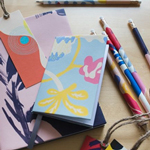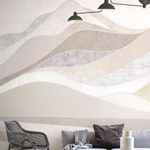
When it comes to home decor, creativity knows no bounds, including the idea of learning how to wallpaper over tiles. Whether driven by the desire to avoid the messy and time-consuming process of tile removal or to cover outdated tiles cost-effectively, many homeowners are intrigued by the possibility of installing wallpaper directly on tiles.
However, this process involves a different approach than wallpapering on regular walls. It includes various considerations and stages, such as tile preparation, understanding wallpaper types, and precise application. In this comprehensive guide, we'll detail each of these aspects.
Preliminary considerations: Can you wallpaper over tiles?
The answer to "Can you wallpaper over tiles?" isn't a simple yes or no, as it depends on various specific conditions. Evaluating these factors will guide your decision: if certain conditions can be addressed by preparing your tiles, you may proceed with wallpapering. If not, you might need to choose a different wall treatment or room. In that sense, this section is vital in determining the feasibility of your project. Here are the factors to consider:
● Tile texture: Wallpapering can be successful if the tiles you plan to cover are even, flat, and smooth without significant depth variation. However, if your tiles are heavily textured or have deep grout lines, you may need to address this by sanding or filling in the grooves, which we’ll discuss later.
● Tile condition: The tiles must be firmly attached to the wall. Any loose or chipped tiles could affect the overall finish and longevity of the wallpaper. Addressing this issue with proper wall preparation is essential.
● Moisture levels: Wallpapering over tiles can work well in areas of your home with lower moisture. However, high-moisture areas like showers or areas directly above a sink or stove can degrade the adhesive over time.
● Ventilation: If you want to wallpaper over tiles, ensure the room is well-ventilated to reduce moisture buildup. This can help prolong the lifespan of the wallpaper and reduce the likelihood of peeling over time.
● Temperature stability: Areas where the temperature changes dramatically might not be suitable for wallpapering over tiles. The frequent expansion and contraction can cause the wallpaper adhesive to fail.
Remember, even with favorable conditions, thorough tile surface preparation is still critical. This includes cleaning, degreasing, sanding for better adhesion, checking and repairing loose tiles, and smoothing the tile surface, which we will discuss in the next section.
Preparing the tiles for wallpapering

Regardless of the type of wallpaper you plan to use or the condition of your room— properly preparing your tiles is crucial for a successful wallpapering project. The condition of the tiles can impact the adhesive bonding and overall aesthetic. So, discover the necessary tools for tile preparation and the steps you need to take before installing wallpaper over tiles.
Tools for tile preparation
Here are all the tools you'll need to prepare your tiles, which include cleaning, sanding, repairing loose tiles, filling the grooves, and smoothing the tile surface.
● Sponge and mild detergent: For cleaning the tiles
● Non-abrasive cleaning solution: For tougher residues on the tiles
● Sanding block or sandpaper: To smooth out the tile surface
● Damp cloth: To wipe away dust after sanding
● Putty knife: To remove loose tiles and apply the spackling paste
● Tile adhesive: To reattach any loose or broken tiles
● Level: To ensure reattached tiles align well
● Spackling paste: To fill the grooves between the tiles
Step 1: Cleaning and degreasing the tiles

Before you start any wallpaper project, working on a clean surface is crucial. Any dirt, grease, or soap scum can prevent the wallpaper adhesive from sticking properly to the tiles, leading to wallpaper issues.
1. Clean the tiles thoroughly: Use a sponge and mild detergent to scrub away any dirt, grease, or soap scum on the tiles. For tougher residues, a non-abrasive cleaning solution can be used.
2. Rinse and dry the tiles: Rinse the tiles with clean water to remove any remaining soap or detergent. Following this, allow the tiles to dry completely before proceeding to the next step.
Step 2: Sanding the tiles for better adhesion
Sanding the tiles is a critical step to promote better adhesion of the wallpaper. Skipping this process might result in the wallpaper failing to adhere properly.
1. Sand the tile surface: Use a sanding block or fine-grit sandpaper to lightly sand the entire tile surface. This process helps create a more porous surface to which the wallpaper adhesive can bond more effectively.
2. Clean away the dust: After sanding, wiping away any dust or debris with a damp cloth is important.
Step 3: Checking and repairing loose tiles

Ensuring all tiles are firmly attached is crucial. If any tiles are loose or broken, the wallpaper may not adhere correctly or cause more tiles to become loose over time.
1. Inspect the tiles: Tap lightly on each tile. A hollow sound can indicate a loose tile. Pay special attention to tiles that are cracked, chipped, or broken.
2. Fix loose tiles: If you find any loose tiles, carefully remove the loose tile using a putty knife, ensuring not to damage the surrounding tiles. Clean the back of the tile and the space on the wall where the tile was located, removing any old adhesive or debris.
3. Apply adhesive: Apply a tile adhesive to the back of the tile. Use enough to cover the tile, but avoid excess that could ooze out when the tile is reattached.
4. Reattach the tile: Place it back in its space on the wall, pressing firmly to secure it. Wipe away any excess adhesive that comes out from the edges. You may use a level to ensure the tile aligns well with the surrounding ones.
5. Wait for it to dry: Allow the adhesive to dry per the manufacturer's instructions before proceeding to the next step.
Step 4: Filling in the grooves and smoothing the tile surface
Filling in the grooves between your tiles and smoothing the tile surface helps prevent the grout lines from showing through your wallpaper, which can ruin its smooth, seamless look. Neglecting this step may result in visible lines and unevenness in your wallpaper.
1. Fill the tile grooves: Use a putty knife and a spackling paste to fill the grooves between the tiles. This step helps prevent the grout lines from showing through the wallpaper.
2. Dry and sand the filling: Allow the spackling paste to dry per the manufacturer's instructions, then sand it down until it's level with the tile surface. Sanding ensures the smoothness and uniformity of the surface, helping the wallpaper adhere more effectively.
3. Clean the surface: Clean away any dust or debris with a damp cloth. A clean, smooth surface is essential before proceeding to the application of the wallpaper.
Now that your tiles are prepared, you can move on to applying your wallpaper.
How to apply different types of wallpaper over tiles
When it's time to wallpaper over tiles, knowing your wallpaper types becomes significant. Why? Although wallpaper type does not affect the tile preparation process, it may affect your installation process. Hence, it's important to understand their nuances at this stage.
So, this section will cover three main aspects: (1) specific considerations for each wallpaper type - with a focus on what to keep in mind for each type during the installation process, (2) tools necessary for wallpaper installation on tiles, and (2) the step-by-step process.
Specific considerations for different wallpaper types during installation

Here are some essential things to keep in mind for each wallpaper type when it’s time to install your wallpaper over tiles:
● Non-woven wallpaper: Non-woven wallpapers are a hit due to their cleaner and easier installation and removal: you may apply them using the paste-the-wall technique. Their tear-resistant nature can be advantageous when working over tiles, as they can withstand a bit of stretching to get into grout lines.
● Peel-and-stick wallpaper: This type is the easiest to install. It comes with a self-adhesive backing, eliminating the need for separate wallpaper adhesive. It can also be adjusted more easily than others during application to align with tile patterns accurately. Although they can be installed on smooth, flat tiles, they are especially not ideal for high-moisture areas.
● Fabric-backed wallpaper: Fabric-backed wallpapers require a strong adhesive due to their weight. The adhesive should be applied evenly, and the wallpaper smoothed out meticulously to prevent any air bubbles or creases.
● Vinyl wallpaper: Vinyl wallpapers, though durable, can be heavy, so a robust adhesive is required to ensure a strong bond. Due to their thickness, they may be less likely to show tile lines or grooves, but a smooth and level surface is still essential for a flawless finish.
Tools for wallpaper installation over tiles

Here's a list of the general tools you’ll need to install wallpaper over tiles successfully:
● Tape measure and straight edge: For measuring and determining wallpaper needs
● Wallpaper adhesive: Necessary for all types except peel-and-stick wallpapers
● Brush or roller: For adhesive application
● Wallpaper smoother: For removing bubbles or wrinkles during installation
● Utility knife: For trimming excess wallpaper
● Seam roller: Useful for smoothing out wallpaper seams
● Sponge and clean water: For cleaning up excess adhesive
General step-by-step guide for wallpapering over tiles

Although each wallpaper type has its specific considerations, the general process of applying wallpaper over tiles is similar for all. Here are the steps on how to wallpaper over tiles:
1. Measure your walls and determine wallpaper needs: Using a tape measure and straight edge, determine the amount of wallpaper needed. You can do this manually, which can be complex, intricate, and time-consuming, or, if using Photowall, by just inputting the dimensions into their system. Here’s a detailed guide on calculating wallpaper needs: How much wallpaper do I need
2. Apply Adhesive: With the accurate amount of wallpaper determined, apply a uniform layer of wallpaper adhesive directly onto the wall or the wallpaper using a brush or roller. Again, this step may be skipped for peel-and-stick wallpapers. Remember, heavier wallpapers like fabric-backed and vinyl types may require a stronger adhesive.
3. Install Wallpaper: Align the wallpaper at the top of the wall, leaving an extra bit for trimming. Smooth out any bubbles with a wallpaper smoother. Ensuring proper alignment is crucial for a professional appearance, and using a smoother helps achieve a perfect finish.
4. Trim Excess: Trim the excess wallpaper at the top and bottom for a clean finish using a straight edge and a sharp utility knife. Precise trimming ensures the wallpaper fits perfectly with your room's unique dimensions and enhances the overall aesthetic.
5. Smooth out Seams: If your wallpaper has seams, use a seam roller to smooth them out gently. Properly handled seams create a continuous pattern flow and a seamless look, contributing to the professional quality of the finished project. Here’s a detailed guide on how to fix wallpaper seams: How to fix wallpaper seams
6. Clean Up: Utilize a sponge and clean water to remove any excess adhesive from the installed wallpaper and surrounding surfaces, ensuring a clean finish to your installation. The most complete guide on how to clean wallpaper is here: How to clean wallpaper
Remember to let the wallpaper dry completely before reattaching any fixtures like switch plates or outlet covers. Now, you're ready to embark on your wallpapering journey.
Final tips: Other considerations for easier wallpaper installation

Installing wallpaper over tiles can present more challenges than applying it to plain walls like plaster and drywall. As you have seen, the uneven surfaces and grout lines require additional preparation and a careful choice of wallpaper type to achieve a smooth finish. That’s why there are several key features that you may want to consider that can help simplify the process. The best way to understand these essential aspects is to explore Photowall's user-friendly offerings:
● Wallpaper types: Photowall offers wall mural types that are easiest to install: non-woven and peel-and-stick wallpapers.
● Sequentially labeled strips: Photowall delivers your wallpaper in strips, carefully labeled in the order they should be hung. This meticulous organization significantly simplifies the process.
● Free wallpaper glue: With Photowall, every non-woven wallpaper order comes with free wallpaper glue, a simple-to-mix powder ready for wallpapering in just five minutes.
● Assembly kit option: Photowall offers an assembly kit for efficient installation. The comprehensive set includes tools such as a glue brush, seam roller, paper hanging brush, knife, cutting guide, spirit level, pencil, and tape measure, guaranteeing accuracy in application.
By choosing a company that offers these advantages, you can simplify the wallpapering process over tiles. You can make the same considerations when applying wallpaper over other wall types, such as drywall and plaster. For a more general guide on the process of wallpaper installation on regular walls, everything you need to know is here: How to install wallpaper
Common mistakes when wallpapering over tiles

Several common mistakes could hamper your efforts when wallpapering over tiles:
● Insufficient surface preparation: Skipping steps like cleaning, sanding, or failing to fill grout lines properly can cause the wallpaper to peel or bubble over time. In fact, many common wallpaper problems, such as fixing wallpaper seams, peeling wallpaper, and air bubbles, can arise from poor surface preparation. If you're encountering these issues, this is the most complete guide available: How to fix wallpaper seams
● Applying too much adhesive: Applying too much adhesive can cause issues like warping or seeping through the wallpaper. It's important to apply a uniform layer and just a proper amount of adhesive to ensure proper installation.
● Rushing the process: Wallpapering is a meticulous process that requires patience. Rushing can lead to errors such as crooked lines, bubbles, and poor alignment. Always take your time and pay attention to detail to achieve the best results.
● Not considering the room conditions: Even though most wallpapers can be installed directly on tiles, it's still essential to consider the specific room conditions. Rooms with high moisture levels may present challenges for adhesion and longevity. In the bathroom, consider wallpapering less humid areas such as around vanities, cabinetry, and shelves. Consider areas away from the sink, dishwasher, and stovetop.
Wallpapering over tiles is no small feat, and yet, as we've explored, it's well within reach for those who approach it with the right tools, techniques, and considerations in mind. From the nuances of preparing tiles to carefully selecting the most suitable wallpaper type, every decision is a step towards a beautifully transformed space.




